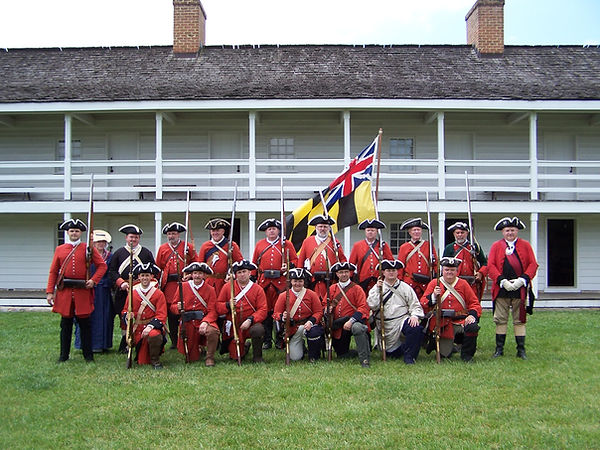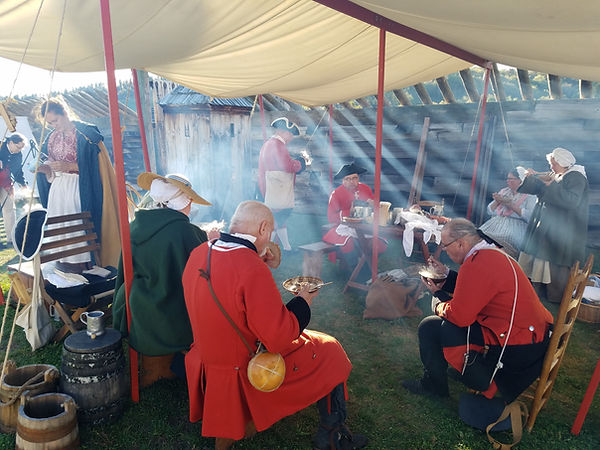Maryland Forces Background
1754-1759
Governor Horatio Sharpe decides to form the Maryland Company in the aftermath of Washington’s Defeat at Fort Necessity on 03 July 1754. This Company would be based at Wills Creek, Maryland and would regularly patrol the Maryland frontier. Captain John Dagworthy was the commander of the first company raised in 1754. In the Fall of 1754, the Maryland Company helped build Fort Mount Pleasant to protect the Ohio Company Storehouses at Wills Creek.
In the Spring of 1755 Dagworthy’s Maryland Company would accompany General Edward Braddock on his campaign to drive the French from Fort DuQuesne which is located at the forks of the Ohio River. They joined the Braddock Campaign when it arrived at Fort Mount Pleasant, Maryland. Shortly after his arrival General Braddock renames Fort Mount Pleasant to Fort Cumberland in honor of the Duke of Cumberland who was the Captain-General of the British Army at the time. General Braddock successfully moved his Army through the frontier regions of Virginia, Maryland, and Pennsylvania. Unfortunately, about seven miles short of Fort DuQuesne the two Armies collide and Braddock’s Army is defeated on 09 July 1755. The Provincial Troops end up covering the retreat after the withdrawal from the Monongahela Battlefield.
In the aftermath of Braddock’s defeat the Maryland Assembly approves a sum of 6000 Pounds to build a new Fort on the Maryland Frontier. Construction begins in May of 1756 and much of it was personally supervised by Governor Horatio Sharpe. The new Fort was located at the foot of North Mountain and would be called Fort Frederick in honor of Frederick Calvert, the Sixth Lord Baltimore. The money was also used to raise additional Companies of the Maryland Forces. A total of five companies were authorized and raised under the Command of Senior Captain John Dagworthy.
From the Fall of 1755 to 1758 the Maryland Forces would regularly patrol the frontier of Maryland in search of French and Indian raiding parties. These patrols were successful in reducing the size of the raiding parties to make it harder to detect them. A smaller raiding party also had to be more selective about the raids that they executed so that they wouldn’t get caught. This reduced the damage that the French and their Indian allies could do on the British frontier. The Maryland Forces would garrison Fort Frederick and Fort Cumberland and several small forts and blockhouses in between during these patrols.
General John Forbes and a new British Army were sent in 1758. The Maryland Forces were asked to join the campaign to again help drive the French from Fort DuQuesne. Governor Horatio Sharpe was supportive of the Maryland Forces joining the campaign. Unfortunately, the Maryland Lower House of the Assembly was not supportive of the troops being used in an offensive operation in another Colony. The Lower House stopped authorizing payment of the Maryland Forces once they entered Pennsylvania on the campaign. General John Forbes had to take the Maryland Forces onto Royal Pay for the duration of the campaign in order to keep the troops in the campaign.
In September of 1758 the Maryland Forces joined Major Grant on his expedition to reconnoiter Fort DuQuesne. Major Grant decided to exceed his orders and attack Fort DuQuesne after he saw the situation there. Unfortunately, the French and their Indian allies very quickly turned the tide and Major Grant and his force were defeated. Of the 77 Maryland Forces members that participated in this operation 27 were killed and 4 were wounded. The remanent of Grant’s Force retreated back to Fort Ligonier to rejoin General Forbes Army.
On 12 October 1758 the French and Indians decide to counter-attack Fort Ligonier to encourage the British to halt the campaign until Spring. They first attacked an outer redoubt that was near the brigaded camp of the Maryland and North Carolina troops. In this attack 13 were killed and 6 wounded in the Maryland Forces. Ultimately, the British were able to repel the French and Indian attack. In the aftermath of the attack the British learned from some of the captured French soldiers how bad things were at Fort DuQuesne. General Forbes decides to send out another force to reconnoiter Fort DuQuesne again. On 25 November 1758 the French blow up the powder magazine and abandon Fort DuQuesne and the British take control of the Forks of the Ohio.
General Forbes had high praise for the Maryland Forces. He said that “Dagworthy commands some of the briskest people I have seen”. Also, he said that the Marylanders were “all good Woods Men”. Additionally, he said “….to do justice I must commend the spirit of some of the provincials, particularly the Maryland troops”.
After the Forbes Campaign the Maryland Forces return to Fort Cumberland and Fort Frederick where they continue their regular patrols of the Maryland Frontier. With the reduced threat to the Maryland Frontier the Maryland Assembly starts reducing the funding of the Maryland Forces. The Companies are mustered out between December 1758 and the Spring of 1759. Lt Colonel Dagworthy’s Company is the last to be mustered out in 1759.
In 1975 the modern Maryland Forces is recreated to provide Living History at various historic sites throughout Western Maryland and the greater region. The unit’s mission is to teach others about the French and Indian War and Maryland’s contribution to that effort. The modern unit is made up of volunteers that help bring history to life for the visitors at events throughout each year.

